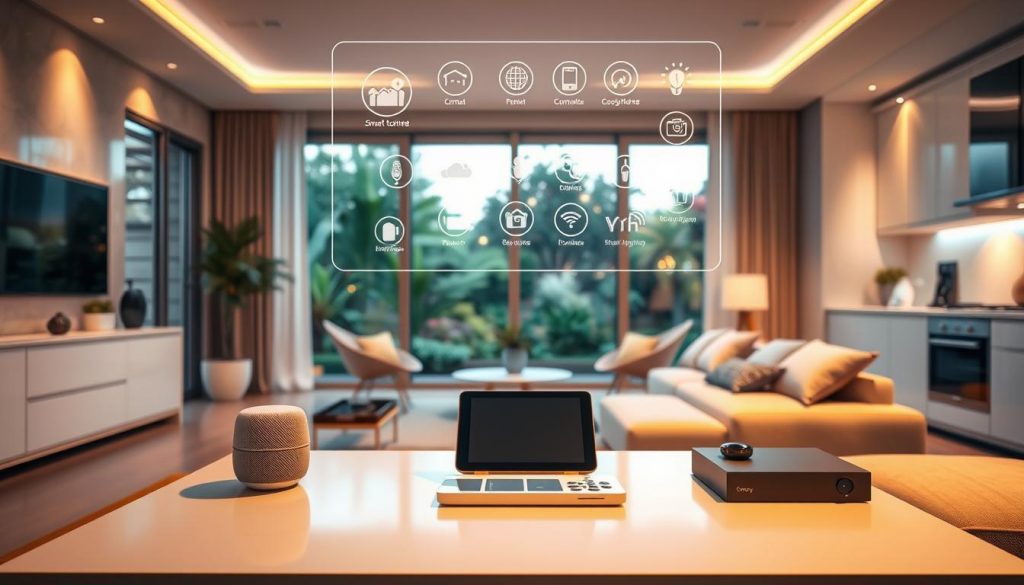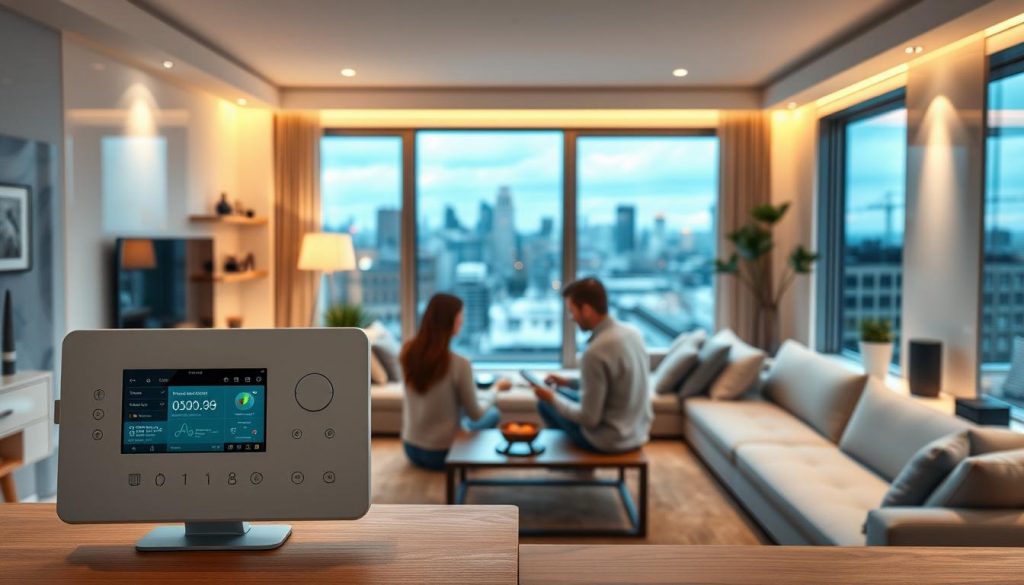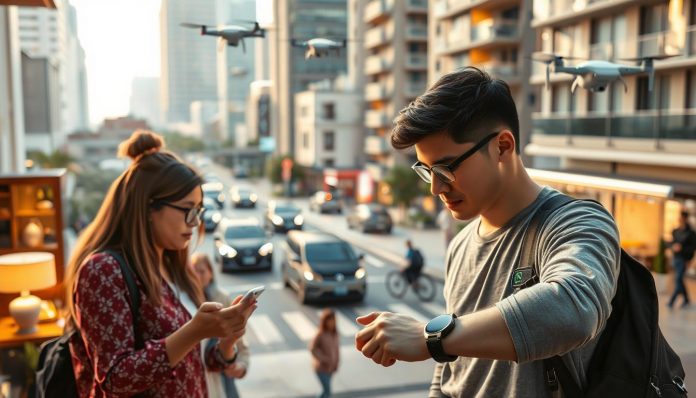3-Part Series: The AI-Powered Consumer Revolution
Part 1: Living with AI: How Intelligent Devices Are Redefining Work, Home, and Health
What if your home could anticipate your needs before you even realise them yourself? This question lies at the heart of modern technological evolution, driven by artificial intelligence systems and innovative AI assistants. These smart devices now permeate every aspect of daily life across the world, adapting to our habits. They transform mundane tasks into seamless experiences through automation and personalisation.
From workplace automation to health wearables, these systems learn from user data, creating efficient environments and adapting to preferences through pattern recognition, ultimately shaping an AI lifestyle.
The integration of these technologies raises questions about data privacy and our relationship with tech, yet their potential to enhance the quality of life is undeniable.
Key Takeaways
- AI is integral to modern lifestyles
- Smart tech automates tasks and personalises experiences
- Workplaces benefit from reduced digital overload
- Homes adapt for comfort and energy efficiency
- Health monitoring provides insights and analytics
- Machine learning evolves with user behavior
- Data security requires ongoing ethical attention
Introduction: The Age of Invisible Intelligence
The kettle boils before you decide to make tea in today’s AI-enhanced world. This invisible intelligence operates in homes and workplaces, shifting how technology serves human needs.
Defining Artificial Intelligence in a Modern Context
AI simulates human cognitive processes through computer systems that learn from data and self-correct based on new information.
Traditional computing requires explicit programming. AI systems learn autonomously, creating adaptive technologies that go beyond basic automation.
| Traditional Computing | AI Systems |
|---|---|
| Requires explicit programming | Learns from data |
| Fixed responses | Adaptive behaviours |
| Limited scope | Continuous improvement |
| Manual updates needed | Self-correcting |
The Pervasive Integration of AI into Daily Routines
Virtual assistants like Siri and Alexa manage tasks via voice commands, controlling devices, and providing instant information. Recommendation algorithms personalise entertainment and shopping.
This integration transforms home control and schedule management. Intelligent systems use pattern recognition, which has become essential in modern living.
Setting the Scene: AI’s Role
Adoption of smart technology has surged, automating tasks across industries and boosting productivity.
AI addresses complex issues, driving innovation while raising ethical concerns. Privacy and workforce impacts need ongoing attention.
The integration of these systems evolves, expanding their role in daily life and presenting opportunities and challenges for society.
Living with AI: How Intelligent Devices Are Redefining Modern Existence
Science fiction’s predictions have become our everyday companions through smart technology, transforming from concepts to practical assistants that enhance routines. Their integration marks a significant technological shift.
From Science Fiction to Everyday Reality
The journey from cinematic fantasy to reality spans decades. Early concepts showed AI as utopian helpers or dystopian threats, but today’s reality is more nuanced.
Modern systems act as invisible partners, managing schedules and anticipating needs without dramatic displays, making them more valuable than fiction suggests.
The Core Principles: Learning, Reasoning, and Self-Correction
Three processes enable smart devices to function: learning, which involves acquiring information and developing rules; and systems, which analyze user behavior and environmental data.
Reasoning enables tools to apply learned rules to new situations, allowing them to reach conclusions without human input and create responsive experiences.
Self-correction ensures improvement, as systems identify errors and refine algorithms over time, creating sophisticated assistance.
Shifting from Manual Input to Autonomous Assistance
The shift from command-based interaction to anticipatory support represents a paradigm change. Traditional tech needed explicit instructions; modern systems analyze context to act preemptively.
This autonomy impacts all aspects of life, creating smoother, more efficient daily experiences.
| Manual Systems | Autonomous Systems |
|---|---|
| Reactive responses | Proactive assistance |
| Fixed programming | Adaptive behaviours |
| Explicit commands required | Contextual understanding |
| Periodic manual updates | Continuous automatic refinement |
This evolution marks a change in human-technology relationships. Systems serve as partners rather than tools, enhancing life through integration and support.
AI at Work: The End of Digital Overload and the Rise of Smarter Productivity
Workplaces are experiencing a quiet revolution in how daily operations are managed. Intelligent systems now handle routine administrative burdens that once overwhelmed professionals. This transformation allows human workers to focus on creative problem-solving and strategic thinking.
The shift represents more than technological advancement—it redefines work itself. Professionals report reduced stress levels and improved job satisfaction. These changes stem from smarter task allocation between humans and machines.
Automating Mundane Tasks to Combat Burnout
Repetitive administrative duties consume mental energy and contribute to workplace fatigue. Intelligent systems now manage data entry, scheduling, and reminder notifications automatically. This automation frees employees from monotonous routines.
Reduced cognitive load allows professionals to maintain focus on value-added activities. The constant context-switching between essential projects and trivial tasks diminishes significantly. Workers experience less mental exhaustion at day’s end.
These systems learn organisational patterns over time. They anticipate routine needs before employees even recognise them. This proactive approach prevents tasks from accumulating into overwhelming piles.
AI Co-workers: Enhancing Human Capabilities and Collaboration
Artificial intelligence partners now complement human teams across industries. These digital colleagues analyse data patterns humans might miss. They provide insights without replacing human judgment.
Collaboration platforms enhanced with smart capabilities improve team coordination. They suggest optimal meeting times based on everyone’s schedules. These systems also facilitate knowledge sharing across departments.
The relationship resembles an apprenticeship rather than a competition. Human workers guide the systems’ learning while benefiting from their computational power. This synergy creates more effective outcomes than either could achieve alone.
Intelligent Tools for Strategic Decision-Making and Efficiency
Advanced analytics tools, including generative AI 2025 products, process vast information streams in real time. They identify efficiency opportunities that escape human notice. These insights support better strategic planning and resource allocation, enhancing human-AI interaction.
Managers receive data-driven recommendations for operational improvements and innovative solutions. The systems prioritise tasks based on organisational objectives and deadlines. This ensures teams focus on what matters most.
Performance monitoring occurs continuously rather than through periodic reviews. Teams can adjust their approaches based on immediate feedback. This creates more responsive and adaptive work environments.
| Traditional Work Environment | AI-Enhanced Workplace |
|---|---|
| Manual task prioritisation | Automated priority management |
| Reactive problem-solving | Predictive issue prevention |
| Periodic performance reviews | Continuous improvement insights |
| Isolated information silos | Integrated knowledge sharing |
| Fixed processes | Adaptive workflows |
The integration of these technologies represents a fundamental shift in work culture. Productivity gains come not from working harder but from working smarter. Employees achieve more while experiencing less stress and greater job satisfaction.
These changes particularly benefit knowledge-based industries. The transformation continues evolving as systems learn from each interaction. The future promises even more seamless collaboration between human and artificial intelligence.
AI at Home: The Rise of Ambient Living and Intelligent Environments
Imagine returning to a house prepared for your arrival. Lights adjust, the temperature is perfect, and your favorite music plays. This is the reality of modern households embracing ambient intelligence.
These systems create responsive living spaces that learn from daily patterns. The technology signifies a shift in how people interact with their environments.

Through observation and data analysis, these environments become attuned to resident needs, offering convenience and energy efficiency. This marks a new era in domestic living across the globe.
Smart Homes That Think Ahead: Learning User Preferences
Modern systems observe routines through monitoring. They learn when residents wake up, their temperature preferences, and light usage. This helps create personalized environments.
The systems automate settings based on these preferences. They adjust thermostats before discomfort, dim lights for relaxation, and prepare entertainment based on past choices.
This capability distinguishes modern smart home AI technology from earlier systems. They understand context and timing, creating smoother daily experiences.
The Internet of Things (IoT) and Seamless Device Integration
The Internet of Things connects devices into a cohesive ecosystem. Smart speakers communicate with thermostats, lights coordinate with security cameras, and kitchen appliances sync with entertainment systems, creating harmony.
AI analyzes data from all devices, identifying patterns that individual devices might miss. This understanding enables sophisticated automation and coordination.
The system might lower blinds when the TV turns on for movie night or adjust heating when windows open. These actions show the power of integrated IoT networks in modern smart homes.
Hands-Free Control: The Central Role of AI Voice Assistants
Voice assistants like Alexa, Siri, and Google Assistant have become central to modern home operation. They allow residents to issue commands without searching for phones or controllers. This hands-free approach enhances accessibility and convenience.
These systems understand natural language requests and execute tasks immediately. Residents can adjust temperatures, play music, or check security feeds using simple voice commands. The technology has become particularly valuable for multitasking households.
The assistants learn from interactions to improve their responses over time. They recognise different voices and adapt to individual speech patterns. This personalisation makes them more effective household managers.
“The home should be the safest, most comfortable place in the world—and technology should make it that way without getting in the way”
These systems represent more than mere convenience—they create environments that support wellbeing. By reducing manual tasks and anticipating needs, they allow residents to focus on what matters most. The technology continues evolving toward even more seamless integration.
Living with AI: How Intelligent Devices Are Redefining Work, Home, and Health
AI-Powered Wearables and Personal Devices
Your morning run now includes a personal health analyst on your wrist. These companions have evolved from step counters to wellness partners, integrating AI in daily life.
Modern wearables collect continuous biometric data through advanced sensors, using algorithms that learn from individual patterns to provide personalised health insights.
Fitness Trackers and Health Monitors: Data-Driven Wellbeing
Fitness trackers now measure physical activity, heart rate variability, blood oxygen levels, and sleep quality simultaneously, offering a holistic well-being assessment.
These devices analyse health data to identify trends, helping users adjust their routines.
The technology is valuable for preventive healthcare, tracking changes to flag potential issues early, and empowering people to address concerns proactively.
Wearables That See What We Can’t: Predictive Health Analytics
Some wearables detect patterns invisible to us, identifying irregular heart rhythms before symptoms appear, marking a significant advancement in health management.
Algorithms analyse historical data with real-time measurements to forecast health concerns based on lifestyle and biometric trends, enabling proactive health approaches.
These systems learn from unique physiological responses, creating accurate predictions as they gather personal data, developing a personalised health model for each user.
Beyond the Wrist: The Expansion of Intelligent Personal Gadgets
Wrist-worn devices are just one type of intelligent health technology. Smart clothing with sensors monitors posture and muscle activity. Connected shoes analyse gait and running efficiency.
These innovations complement traditional wearables, offering varied insights into health and activity. This multi-device ecosystem creates a fuller health picture.
Integration with mobile apps allows data analysis. Users can track trends and share info with healthcare professionals, enhancing the value of health data.
“The most profound technologies are those that disappear. They weave themselves into the fabric of everyday life until they are indistinguishable from it”
Adoption of these technologies has surged globally. About 34% of consumers automate health decisions through intelligent devices, showing growing trust in data-driven wellness.
These systems combine fitness tracking with mental wellness support, incorporating meditation and breathing exercises alongside activity monitoring. This integrated approach fosters both physical and emotional resilience.
The future promises even more seamless health integration through wearables. As algorithms and sensors advance, these devices will provide increasingly valuable insights, representing a shift toward proactive, personalised health management.
AI in Health: The Rise of the Digital Caregiver
A quiet revolution is transforming the approach to wellness and medical care. Digital systems now offer personalised attention that was once only available through human professionals, showcasing the impact of artificial intelligence in health. These technologies provide continuous monitoring and tailored advice directly to individuals, integrating seamlessly into their everyday life.
This shift represents a fundamental change in healthcare delivery. It moves from periodic clinic visits to constant, data-driven support. The technology empowers people to take control of their wellbeing with unprecedented precision.
These systems analyse vast amounts of personal health information. They identify patterns that might escape human notice during brief appointments. This creates more proactive and preventive care models.
Personalised Wellbeing: The AI Health Coach in Your Pocket
Mobile apps serve as wellness advisors, processing health metrics to create custom plans. They adjust recommendations based on real-time feedback.
These systems suggest exercises and provide nutritional guidance, while medication reminders ensure treatment adherence.
Lifestyle recommendations help users maintain routines, evolving with individual needs.
Revolutionising Patient Care through Remote Monitoring and Telemedicine
Remote monitoring allows continuous tracking of conditions, with data securely transmitted to medical teams.
Real-time tracking reduces hospital visits and enables early intervention, improving outcomes and reducing costs.
Telemedicine facilitates virtual consultations, providing valuable medical advice without travel.
Diagnostic systems analyse medical data, enhancing accuracy and treatment planning.
For a deeper understanding, read this article on Forbes
Mental Health Support: AI Chatbots and Emotional Wellbeing Applications
Digital mental health tools offer immediate support for emotional challenges, using natural language processing for conversations.
They monitor mood patterns, enabling early intervention for declining mental health.
Many applications use cognitive behavioral techniques and can connect users with professionals for additional support.
“The most profound healthcare technologies are those that provide support exactly when and where it’s needed most”
These digital caregivers signify a shift in healthcare, making support more accessible and preventive.

Addressing Key Challenges: Data Privacy, Security, and Energy Consumption
Data privacy is a concern for users as intelligent systems collect personal information. Consumers question how this data is stored and protected.
Security is crucial for home access systems, necessitating robust protection measures that manufacturers address with improved encryption.
Energy consumption is a challenge, as devices need a constant power supply. Sustainability is now critical in product design.
Regulators and manufacturers work on transparent data policies to build consumer confidence, recognising that trust is key to adoption.
Conclusion: Living with AI: How Intelligent Devices Are Redefining Work, Home, and Health
As AI becomes central to life, understanding its impact is crucial. The technology offers benefits across work, home, and health management.
These systems enhance efficiency through automation and personalisation, representing a significant technological shift.
Data privacy and overreliance challenges require careful consideration. Sustainable adoption depends on maintaining human oversight.
The future promises more sophisticated assistance through anticipatory systems, ensuring these technologies enhance the quality of life.


